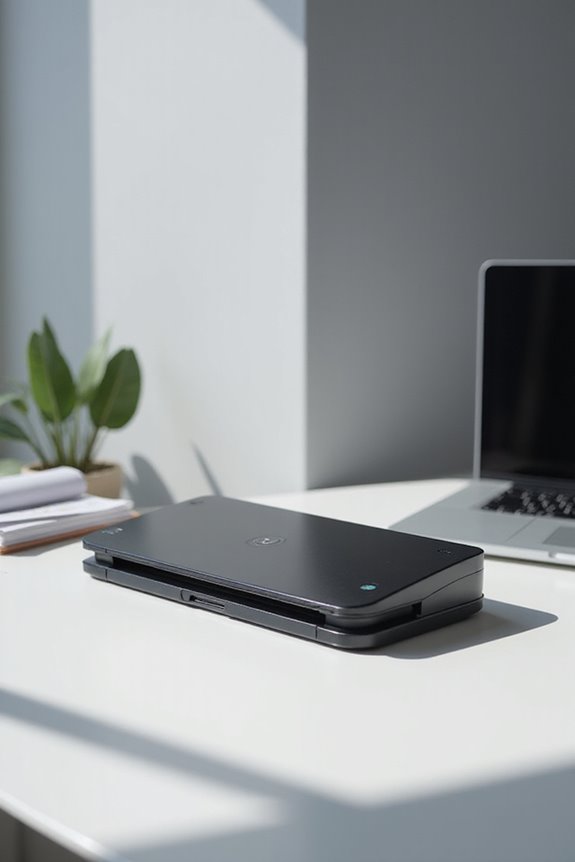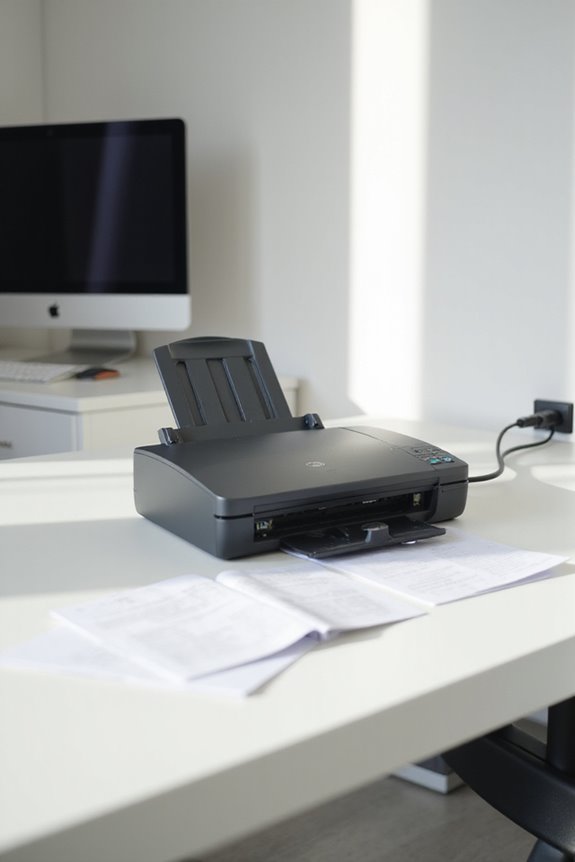Upgrading our home office with a scanner boosts productivity and streamlines document handling. We should choose a sheet-fed scanner for multiple-page documents, as it can process up to 40 pages per minute. Features like automatic brightness adjustment and duplex scanning enhance scan quality and efficiency. Integrating software automates workflows, improving collaboration. Regular maintenance, like cleaning every 1,000 scans, guarantees peak performance. Let’s explore more about selecting the right scanner and maximizing its potential for our workspace.
Key Takeaways
- Assess your scanning needs to choose the right scanner type, such as a sheetfed or flatbed scanner, for your home office tasks.
- Implement fast scanning capabilities and advanced paper handling features to enhance productivity and reduce time spent managing documents.
- Utilize cloud connectivity to streamline file sharing and improve collaboration with team members in your home office.
- Integrate scanner software to automate workflows, ensuring high scan quality and reducing the risk of manual data entry errors.
- Establish regular maintenance practices, like cleaning and calibrating the scanner, to ensure optimal performance and longevity.
Choosing the Right Scanner for Your Home Office
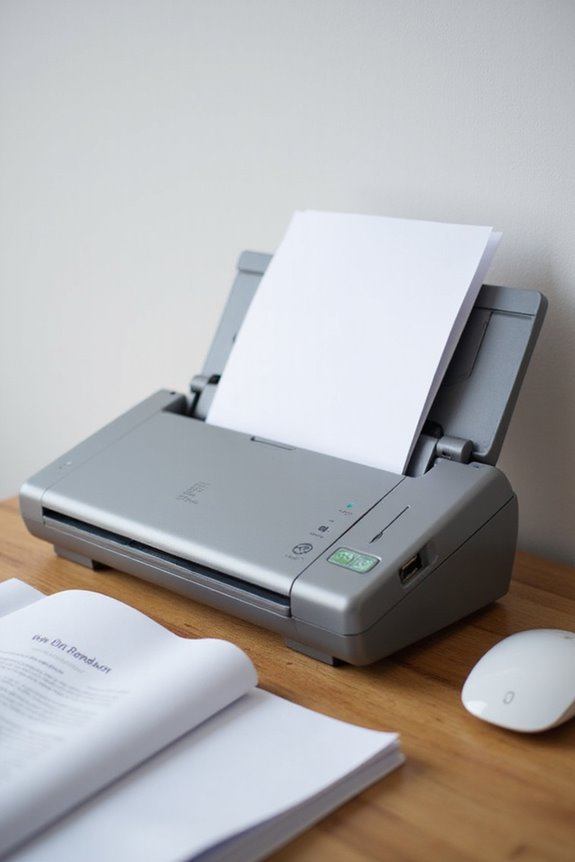
How do we choose the right scanner for our home office? First, we need to evaluate our specific scanning needs. For those focused on multiple-page documents, sheetfed document scanners excel with high volume capacity. If we frequently scan photos, a dedicated photo scanner’s high resolution guarantees color accuracy. Also, portable scanners provide on-the-go functionality, great for tight spaces. We should consider scanner types that fit our workflow, integrating scanning technologies like Optical Character Recognition (OCR) for editable text. Additionally, weighing connectivity options, such as USB and Wi-Fi, can streamline our setups. Finally, let’s not forget about size and portability—these factors play a significant role in our daily efficiency and ease of use. Furthermore, it’s essential to look for features like scanning speed to ensure timely processing of our documents.
Essential Features to Enhance Productivity

When we consider enhancing productivity in our home office, crucial scanner features play a significant role. Fast scanning capabilities, like those achieving up to 40 pages per minute, drastically reduce our workflow time. Advanced paper handling, including mixed-size handling and automatic document feeders, further streamline the scanning process. Additionally, skew-reducing functionality guarantees our documents are aligned perfectly, providing clearer images.
Advanced image processing features, such as automatic brightness adjustment and shadow removal, improve the overall scan quality. A user-friendly interface, especially with touch-screen functionality, simplifies our operational tasks. By integrating duplex scanning and cloud connectivity, we can easily upload documents, increasing efficiency and collaboration. All these features contribute remarkably to our productivity in the home office environment. Moreover, models like the Epson WorkForce ES-400 II are specifically designed to enhance document management and scanning speed.
Types of Scanners and Their Benefits
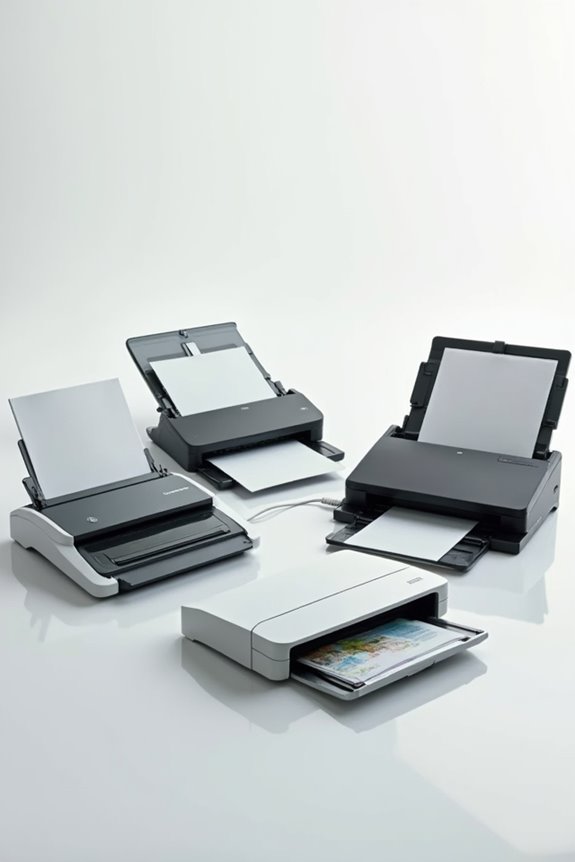
Selecting the right scanner can greatly impact our home office efficiency. Flatbed scanners are versatile and perfect for occasional use, ideal for photos and fragile documents with high resolutions up to 4,800 DPI. If we frequently handle large batches, sheet-fed scanners excel, processing over 20 pages per minute with their automatic document feeder. For larger workflows, production scanners service high-volume needs, scanning 50+ pages per minute and offering simultaneous output. Enthusiasts of photos will appreciate the high fidelity of dedicated photo scanners, boasting resolutions up to 6,400 DPI. Finally, mobile scanning apps provide a quick solution with basic OCR features, though image quality lags. By making informed scanner comparisons, we can choose the best scanning techniques for our unique requirements. Additionally, understanding scanner technology trends can further enhance our selection process and ensure we invest in the most suitable device for our needs.
Integrating Software for Workflow Improvement
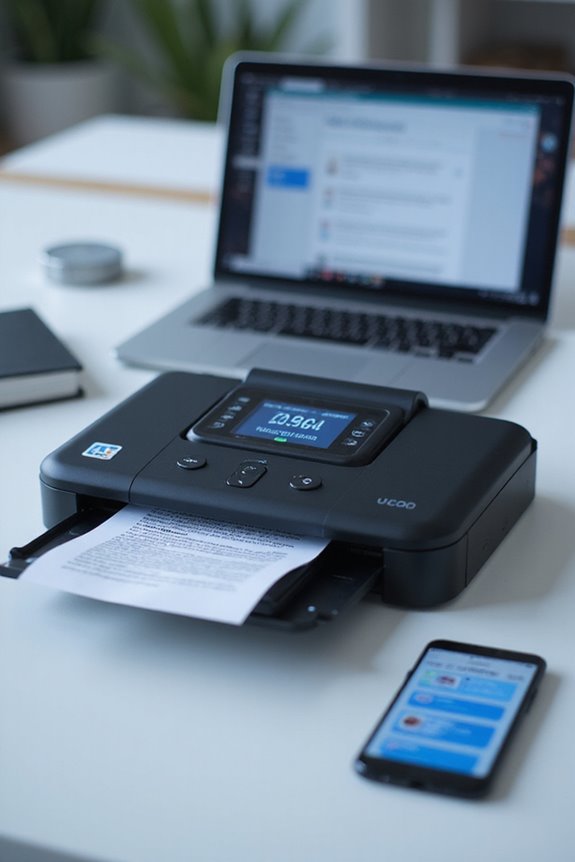
Integrating software into our scanning processes can transform how we manage documents in a home office. By utilizing scanner software for workflow automation, we gain precise control over scan quality, adjusting brightness and contrast for clarity. This software supports real-time file access across multiple computers, speeding up sharing and collaboration. Furthermore, it automatically encrypts data during transfer, enhancing our document security. With remote access options, we’d enjoy added flexibility in managing our workflows. Additionally, integrating scanned documents directly into our business systems reduces errors and manual entry, improving efficiency. Ultimately, a streamlined document management lifecycle offers cost savings and guarantees compliance with regulatory standards, making our home office more effective and organized. Moreover, the incorporation of Optical Character Recognition (OCR) allows for the conversion of scanned images into editable text, further enhancing our document handling capabilities.
Maintenance Tips for Optimal Scanner Performance
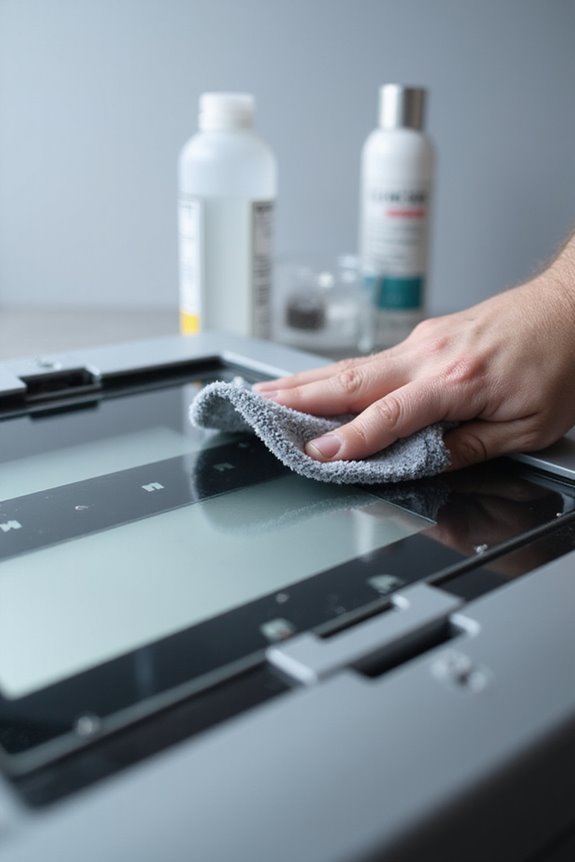
Maintaining ideal scanner performance is as important as integrating software for workflow efficiency. To guarantee scanner longevity, we must establish effective cleaning protocols. Regular cleaning, at least once a week or every 1,000 scans, prevents dust and dirt buildup that can hinder performance. Using isopropyl alcohol and soft cloths keeps surfaces pristine, while cotton swabs reach those tricky spots. We should also stay on top of software updates to address compatibility issues and fix bugs. Periodically calibrating the scanner guarantees accurate results, and professional servicing can identify maintenance needs early. Let’s monitor component wear and properly manage the scanner’s environment to enhance durability. By following these practices, we can enjoy excellent scanner performance and longevity for our home office. Additionally, utilizing non-toxic cleaners ensures safe and effective maintenance of scanner glass.
Cost Considerations for Your Scanner Investment
When considering upgrading our home office scanner, it’s essential to evaluate not just the upfront price but also the total cost of ownership. Our initial investment can vary widely, with entry-level models like the Canon Canoscan LiDE 300 starting around $56. While budget scanners serve basic needs, mid- to high-end options, such as the Fujitsu ScanSnap iX1300, offer features that may justify a higher price for efficient, frequent use. Additionally, we should factor in costs for any necessary accessories, software licenses, or warranties. By understanding these elements, we can make informed decisions that lead to long term savings, ensuring we choose the right scanner for our home office with minimal ongoing expenses. Moreover, considering options like the Epson WorkForce ES-50 can enhance our scanning experience with efficient speed and portability.
Maximizing Space Efficiency With Scanner Solutions
Upgrading our scanner not only involves considering cost but also how it fits into our workspace. A compact design, like that of the Epson WorkForce ES-C320W, provides a space-saving solution ideal for tight areas. Weighing just 3.85 pounds, it’s lightweight and easy to move. Wireless connectivity allows us to place the scanner away from other devices, maximizing desk space while maintaining accessibility. Features such as a 20-page Auto Document Feeder enhance efficiency, enabling us to process documents swiftly without additional clutter. With high-speed scanning at 30 pages per minute and multifunctionality, our workflow improves, shifting smoothly to a paperless environment. These features surely help us create a functional and organized home office.
Frequently Asked Questions
How Do I Connect My Scanner to a Computer?
To connect our scanner, we can start with the scanner setup process. Depending on the connection types—USB or wireless—we’ll follow the appropriate instructions to guarantee successful integration with our computer for efficient scanning.
What Types of Documents Can I Scan?
Picture a cluttered desk drowning in papers. We can actually scan various document types—like receipts, contracts, and photographs—to reap scanning benefits, turning chaos into organized digital files, effortlessly creating a clearer, more productive workspace.
Can I Scan Directly to My Email?
Yes, we can scan directly to our email by configuring the email settings on our scanner and using compatible scanning apps. This process simplifies sharing documents quickly and efficiently right from our home office setup.
How Do I Troubleshoot Scanning Issues?
When we troubleshoot scanning issues, we should consider scanner maintenance tips and adjust document resolution settings. Ensuring drivers are updated and checking connections help us resolve problems effectively and improve our scanning experience.
Is It Possible to Scan in Color or Black and White?
Absolutely, we can choose between color scanning and black and white scanning. Each has its purpose: color for vibrant images and text, while black and white is perfect for text-heavy documents, ensuring clarity and efficiency.

